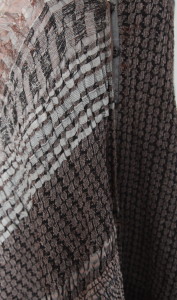Ahimsa is the Sanskrit word for the doctrine of non violence and peace subscribed to by Hindus, Buddhists and Jains, recently tagged to silk production, covering the old traditional methods and promoting a new way to produce silk whilst sparing the life of the silk worm.
In this natural production method, the silkworm emerges from its cocoon creating an open end, as it does so it breaks the single filament of almost a mile-long that made the cocoon. The resulting short fibres are softened and spun, creating a fabric with more of a ‘country style’ look.
In commercial sericulture, the worm is destroyed in the cocoon before it emerges, in order to preserve the length of gossamer-like thread, which can be reeled and woven into the beautiful fine, strong silk we’ve come to expect. With commercially obtained silk at least 80% is useable, as opposed to only 16 % of broken cocoons from wild cultivation.
As with much conservation policy, there is no one straightforward solution applicable to all silk producing regions. For example, for non-vegetarians, the boiled and roasted silk worms are a source of nutrition, at the very least a roadside snack, and for some the pupa is even a delicacy, providing a good and reliable source of protein, which in effect means a double harvest. However, for vegetarians, for whom the 1,500 pupa required for 1m of cloth are not a delicacy, and whose priority lies in preserving all life, the Ahimsa practice of wild silk is the preferred solution.
On the face of it Ahimsa silk is less economical and less competitive in the market place, a more time consuming harvest for a much smaller return. However, from an ecological, sustainable, community-focused perspective, wild cultivation has huge potential and backing. Micro-finance projects are investing in the setting up and training of cultivators, spinners and weavers within the immediate forest communities, to encourage a change over to the Ahimsa process. Women in particular thereby gain a sustainable livelihood.
The Ahimsa banner specifically covers wild silk–cultivated on forest trees, harvested only after the silkworm has metamorphosed and flown the cocoon. Although such yarn is less smooth, it typically has improved lustre. We could all do with better appreciating the rationale of imperfect purity so inherent to natural methods.
See MUGA, ERI, ERRANDI, ENDI, PAT, ASSAM
A snapshot from the workshops of Studio Akaaro- pieces of Ahimsa silk designed and woven by Gaurav Jai Gupta

 www.akaaro.com
www.akaaro.com